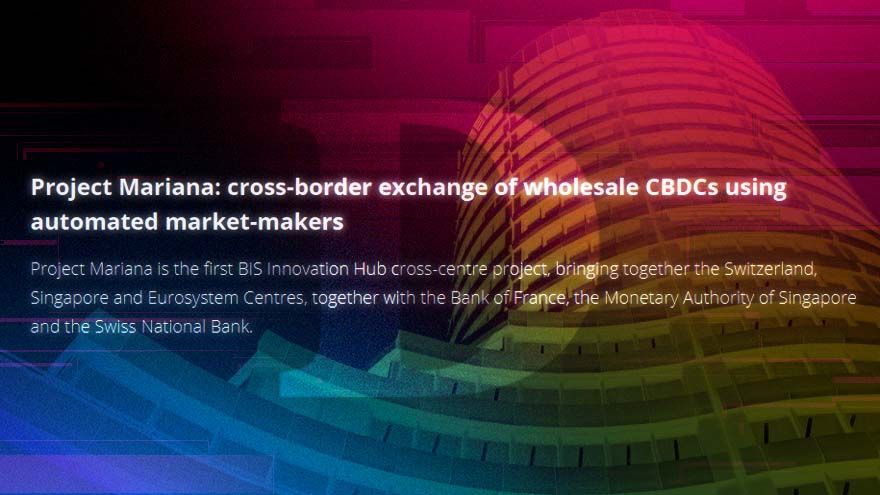The Bank For International Settlements, a transnational financial institution colloquially known as the central bank of central banks, has published its interim report for Project Mariana, a cross-border CBDC pilot program that leverages Curve’s AMM design.
The June 28 report details the findings and technical infrastructure built during the 11 months since the initiative was launched. Project Mariana examines whether automated market makers (AMMs), an exchange mechanism underpinning most leading decentralized exchanges, could improve the efficiency and transparency of foreign exchange trading and settlement.
As part of the initiative, BIS launched an AMM exchange for wCBDCs on Ethereum’s Sepolia testnet that borrows its bonding curve from Curve v2, a popular stablecoin DEX. Wholesale CBDCs (wCBDCs) are digital currencies used for inter-bank settlement.
“Project Mariana looks to a future world where central banks have issued [wCBDCs] and explores novel options for tokenized FX trading and settlement,” the report said. “With the tokenization of financial markets on the horizon, market participants, including central banks, need to understand its transformative potential.”
Project Mariana is a joint initiative from the BIS Innovation Zone, the Bank of France, the Swiss National Bank, and the Monetary Authority of Singapore.
The BIS’s exploration into the efficiency gains offered by AMMs, a core DeFi primitive, shows that central banks and global institutions are beginning to recognize the benefits associated with web3 technologies and decentralized finance.
However, the BIS said the project “is purely experimental and does not indicate that any of the involved central banks intend to issue a CBDC or endorse DeFi or a particular technological solution.”
The news also comes as major financial institutions are competing to stake their claim to profit from the next bull market, with BlackRock, the world’s largest asset manager, triggering a spate of Bitcoin ETF filings over the past fortnight.
Project Mariana
BIS launched Project Mariana in July 2022 to experiment with wCBDC-based foreign exchange trading using an interbank AMM.
The pilot explored foreign exchange spot trading and settlement using hypothetical Euro, Swiss franc, and Singapore dollar (SGD) wCBDCs. BIS also designed bridges to facilitate asset transfers between domestic wCBDC systems, which comprise permissioned versions of Ethereum and Sepolia.
Project Mariana chose to use the bonding curve developed for the Curve v2 AMM to assess whether the design would minimize the price impact of large transactions. Curve’s value proposition is its unique bonding curve, which was designed to minimize slippage when swapping between stablecoins or other soft-pegged assets.
Commercial banks acted as liquidity providers to the pools, receiving LP tokens that would accrue a share of the trading fees generated from trades settled.

Curve’s CRV token is up roughly 5% in the past week in choppy trading.

Modified ERC-20s
The report said Project Mariana leveraged a modified version of Ethereum’s popular ERC-20 fungible token standard to issue its hypothetical wCBDCs. BIS emphasized the benefits of using a common token standard to ensure interoperability between the systems of different central banks.
“Interoperability may allow for flexibility in a future tokenized financial system in which central banks’ autonomy is retained in the domestic context while avoiding walled gardens.”
The token standard also allows central banks to mint and destroy wCBDC tokens, maintain a whitelist of commercial banks that can interact with its wCBDC, recover tokens from sanctioned commercial banks, and pause transactions. The standard also allows central banks to upgrade their wCBDC contracts.
BIS will publish its final report on Project Mariana later this year.
Read More: thedefiant.io









 Bitcoin
Bitcoin  Ethereum
Ethereum  Tether
Tether  XRP
XRP  Solana
Solana  USDC
USDC  Dogecoin
Dogecoin  Cardano
Cardano  TRON
TRON  Lido Staked Ether
Lido Staked Ether  Wrapped Bitcoin
Wrapped Bitcoin  Sui
Sui  Hyperliquid
Hyperliquid  Wrapped stETH
Wrapped stETH  Chainlink
Chainlink  Avalanche
Avalanche  Stellar
Stellar  Shiba Inu
Shiba Inu  Bitcoin Cash
Bitcoin Cash  Hedera
Hedera  LEO Token
LEO Token  Toncoin
Toncoin  Litecoin
Litecoin  Polkadot
Polkadot  WETH
WETH  Monero
Monero  USDS
USDS  Pepe
Pepe  Wrapped eETH
Wrapped eETH  Bitget Token
Bitget Token  Binance Bridged USDT (BNB Smart Chain)
Binance Bridged USDT (BNB Smart Chain)  Pi Network
Pi Network  Ethena USDe
Ethena USDe  Coinbase Wrapped BTC
Coinbase Wrapped BTC  WhiteBIT Coin
WhiteBIT Coin  Bittensor
Bittensor  Uniswap
Uniswap  Aave
Aave  NEAR Protocol
NEAR Protocol  Dai
Dai  Aptos
Aptos  Jito Staked SOL
Jito Staked SOL  Ondo
Ondo  OKB
OKB  Internet Computer
Internet Computer  Ethereum Classic
Ethereum Classic  Cronos
Cronos  BlackRock USD Institutional Digital Liquidity Fund
BlackRock USD Institutional Digital Liquidity Fund